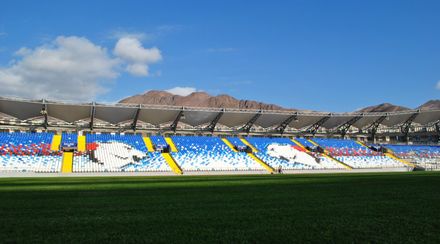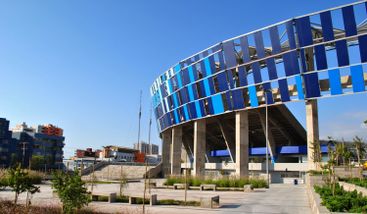
Antofagasta Regional Stadium
ARCHITECTS
Nicolás Lipthay, Valle & Cornejo Arquitectos
MANUFACTURERS
Serge Ferrari
LANDSCAPE
Rencoret & Rüttimann Arquitectura Del Paisaje (Cecilia Rencoret, Carla Rütimann)
STADIUM CAPACITY
21100 Spectators
MATERIALIDAD
Exposed Concrete Smooth Finish, Karikal Phenolic Resin Facade Plates, Hunter Douglas Mini Wawe Panels For Press Area, Ferrari Canvas For Roof.
CONSTRUCTION
Navarrete & Diaz Cumsille Ingenieros
COLLABORATORS
Juan Pablo Duarte, Catalina Donzé, Oscar Conteras, María José Yurisic
YEAR
2013
LOCATION
Antofagasta, Chile
CATEGORY
Stadiums, Renovation
Text description provided by architect.
The commission for the architectural design of the Regional Stadium is understood to be based on the regularization and formalization of an existing building.
Regularization assumes an existing building, in this case, the Regional Stadium building and its public area, and establishes an operation on it that allows for the mutation of the previous situation, taking advantage of the existing potentials and improving its architecture and aesthetics.
In the case of the Regional Stadium, the operation seeks to respect the existing structure as a recognizable city landmark, and generate an architectural unity to all of its parts, a unity which is currently not perceived due to the different interventions on the building over time.

The project is understood from the need to generate a new reading of the stadium as a whole.
The architectural operation consists of composing a gesture, simple, clean, elegant, continuous in its entire perimeter, that embraces the existing elements, encloses them, and gives a new presence to the regional stadium towards the city.

A gesture like a ribbon, an enclosure of the building, that builds continuity and also supports new structures, strengthening the reading of access points, the relationship with the slope, respecting the aesthetic and architectural value of the volume of the stands, enhancing the color and image of the urban environment.
The gesture is complemented with design operations on the public areas of the building, where we propose a serious landscape and architecture design that organizes the circulation and highlights the crowd and meeting areas.
This operation is completed with the work towards the interior of the sports building, areas for the public, and competition surfaces, Where the gesture is understood on the ring-shaped roof that builds the unity of the building as a sports event, a roof that is shade and shelter for the public, framing a void into the sky and into the landscape of the hills above the stands.
In the relationship with the immediate context, we took on the challenge of designing the meeting areas of the stadium with Avenida Angamos.

This area lacked space and generated a confrontation of circulations and traffic jams given the distance between the stadium and the public sidewalk.
The design gesture was to organize the access from two plazas at the ends of the stadium, leading the circulation to the stands through a walkway parallel to Calle Angamos
This walkway becomes a great urban balcony of the stadium to the city, revealing the circulation as part of the sporting event.
The work on the access plazas and exterior circulation is a fundamental contribution to improving the reading of the stadium, as they have been designed to provide shaded areas and contribute to the urban environment with a landscape proposal.































